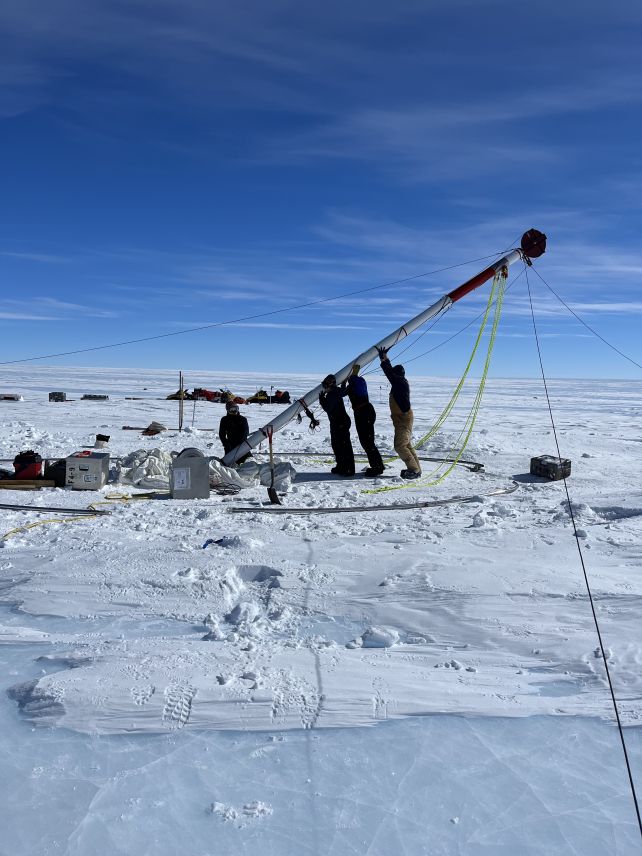Ice excavated from deep under the surface of Antarctica has just yielded humanity's oldest directly dated samples of glacial ice and air ever found.
From beneath hundreds of meters of glacial ice that gradually accumulated over eons at Allan Hills, a team of scientists led by glaciologist Sarah Shackleton of the Woods Hole Oceanographic Institute has retrieved samples that have been buried for some 6 million years.
"Ice cores are like time machines that let scientists take a look at what our planet was like in the past," Shackleton says.
"The Allan Hills cores help us travel much further back than we imagined possible."
Related: Mountain Range Hiding Beneath Antarctica's Ice Frozen in Time, Study Finds

Because our planet is so geologically active, finding records of past climate can be challenging.
Antarctica is one exception; there, the constant accumulation of ice and snow traps and freezes material, creating a time capsule record of Earth's climate history. By studying ancient ice in vertical cores extracted from ice hundreds of meters thick, scientists can reconstruct our planet's past environmental conditions, at least at Antarctica.
At Allan Hills, the concentration of blue ice is particularly valuable. This is ice that has been compressed over time, squeezing out larger air bubbles and enlarging the ice crystals, so that the resulting ice absorbs redder wavelengths, lending it a distinctly blueish hue. Because Allan Hills no longer accumulates snow due to weathering and sublimation processes, the older ice is closer to the surface than in other parts of Antarctica.
"We're still working out the exact conditions that allow such ancient ice to survive so close to the surface," Shackleton explains.
"Along with the topography, it's likely a mix of strong winds and bitter cold. The wind blows away fresh snow, and the cold slows the ice to almost a standstill. That makes Allan Hills one of the best places in the world to find shallow old ice, and one of the toughest places to spend a field season."

Although this ice has no visible air bubbles, it still contains microscopic pockets of air, so densely packed that they occupy tiny spaces in the ice's crystal structure. These compressed pockets of air are highly prized for the window they offer into Earth's early climate.
The National Science Foundation COLDEX project drilled three Allan Hills cores from depths of 150, 159, and 206 meters (492, 522, and 676 feet, respectively). In these cores, the researchers hoped to find ice old enough to help tap into the Pliocene climate. This epoch ended about 2.6 million years ago.
"We knew the ice was old in this region," says paleoclimatologist and COLDEX director Ed Brook of Ohio State University.
"Initially, we had hoped to find ice up to 3 million years old, or maybe a little older, but this discovery has far exceeded our expectations."

When they performed argon isotope dating of their samples – a method that allows direct dating, as opposed to inferred dating based on other material around the sample – the researchers found that the deepest of the three had ice up to about 6 million years old, towards the end of the Miocene epoch, about 5.3 million years ago.
Other tested samples were younger, providing the researchers with a series of snapshots spanning the end of the Miocene and most of the Pliocene.
Next, the researchers performed oxygen isotope analysis to gauge temperature conditions at each of their 'snapshots'.
They found that 6 million years ago, Antarctica was about 12 degrees Celsius (22 degrees Fahrenheit) warmer than it is now, and that the cooling to its current temperature was a smooth, gradual process rather than a sudden one.
Going forward, the researchers hope to reconstruct the contents of Earth's atmosphere at these different times to determine what greenhouse gases were present, in which concentrations, and how that profile may have changed over time.
And, of course, they're going to go back to the ice to retrieve more data trapped within.
"Given the spectacularly old ice we have discovered at Allan Hills, we also have designed a comprehensive longer-term new study of this region to try to extend the records even further in time, which we hope to conduct between 2026 and 2031," Brook says.
The research has been published in the Proceedings of the National Academy of Sciences.

